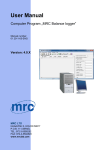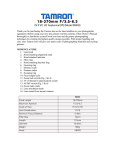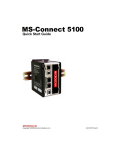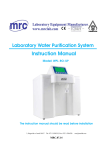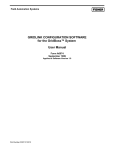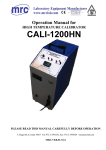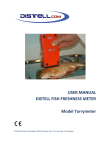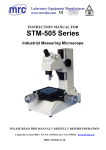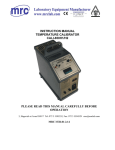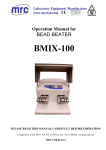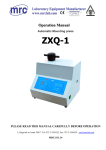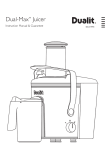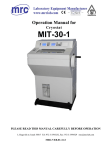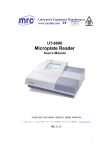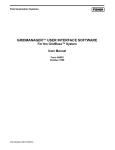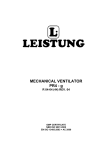Download FIA-6
Transcript
Operation Manual Fiber Analyzer FIA-6 PLEASE READ THIS MANUAL CAREFULLY BEFORE OPERATION 3, Hagavish st. Israel 58817 Tel: 972 3 5595252, Fax: 972 3 5594529 [email protected] MRC. 5.15 Contents I. SUMMARY ................................................................................................................. - 1 II. PERFORMANCE ..................................................................................................... - 3 III. STRUCTURE .......................................................................................................... - 5 IV. INSTALLATION ...................................................................................................... - 7 V. OPERATION ............................................................................................................ - 8 VI. CAUTIONS ............................................................................................................ - 21 VII. MAINTENANCE .................................................................................................. - 21 - FIA-6 User Manual V1.1 Warning: The responsible person must be clear that the protective function of this instrument can be impaired if the method adopted by the user during the operation procedure is not the same as the method specified by the manufacturer. Warning: All kinds of solvents should be placed with care during analysis procedure in accordance with the lab safety regulations. Refer to corresponding material safety data sheets. If possible, please wear lab coat, goggles and rubber gloves. To avoid the possible burns, be careful with hot reagents. Warning: Shock hazard.The cover or plate should be removed only by the qualified personnel. FIA-6 User Manual V1.1 I. Summary It is of great importance in analyzing the crude fiber of food, feed, grain and other agricultural products, but the traditional manual crude fiber determination is complex and has a certain danger in using hot acid and alkali solvent. As to resolve the problem, our company launches FIA-6 fiber analyzer, which is specialized in analyzing the content of crude fiber, NDF, ADF, ADL, cellulose, semi-cellulose in materials and finished products of food, grain and feed. This instrument, based on the crude fiber determination principle, adopts high quality anti-corrosion materials and can process six samples simultaneously. Its precise design optimizes the operations, such as acid and alkali hydrolysis, cold and hot leaching, air pump back-blowing, automatic emptying and electronic temperature control. 1 Crude Fiber Determination Principle The sugar, starch, pectin and semi-cellulose in the sample, under the action of dilute sulfuric acid, are firstly removed by the hydrolysis, and then protein and fatty acid in the sample are removed by the alkali treatment, and the left residue is the crude fiber. And the impurities, which are insoluble in acidic and alkali solutions, in the fiber can be removed by ashing. In view of the determination principle, the crude fiber is not a specific chemical entity but a mixture. Its rough ingredients, determined under recognized compulsory conditions, mostly are cellulose and few are semi-cellulose and lignin. 2 Operation Procedure -1- FIA-6 User Manual V1.1 -2- FIA-6 User Manual V1.1 II. Performance ●Procedure: acid-washing, flushing, alkali-washing, derosination and filter ●Sample weight: 0.5g -3.0g ●Measurement range: 0.1-100% ●Repeatability error: With crude fiber content under 10%, the absolute value error ≤0.4 %; With crude fiber content larger than 10%, the absolute value error ≤4 %; ●Capacity per batch: 6pcs./batch ●Determination time: about 90 min on the instrument ( consisting of 30 min for acid-washing, 30 min for alkali-washing, and 30 min for filter and flushing) ●Built-in air pump: back-blowing pressure >4 bar ●Built-in diaphragm liquid pump: negative pressure discharge 800 Mbar ●Heating manner: infrared radiation heating ●Heating power is continuous and adjustable ●Power supply: 220 VAC ±10% 50Hz; ●Power: 3200W ●Dimension (mm): 482×560×765 ●Weight (kg): 45 Kg -3- FIA-6 User Manual V1.1 Cautions If the samples blister easily, it should be heated to slightly boiling. During Preheating, solvent in the three glass tanks should be avoided to be violent boiling. After experiment, all solvent in the tanks should be evacuated immediately. When adding solvent into glass tanks, 2 cm between the solvent level and bank neck should be left to prevent the solution boiled overflow. line. -4- FIA-6 User Manual V1.1 III. Structure Fig. 1 Instrument front view 1 Acid solvent glass tank; 2 Alkali solvent glass tank; 3 Distilled water glass tank; 4 Digestion pipe; 5 Infrared heating area; 6 Lifting brake linkage; 7 Heating knob; 8 Displaying screen; 9 Operation panel; 10 Sample pedestal; 11 Heating pipe baffle; -5- FIA-6 User Manual V1.1 Fig. 2 Instrument right side view 12 Fuse; 13 Power plug; 14 Over current leakage protector; 15 Power switch; Fig. 3 Instrument left side view 16 Water inlet; 17 Waste liquor outlet; 18 Water outlet; -6- FIA-6 User Manual V1.1 IV. Installation 1 Installation Conditions (1) Input voltage: 220 VAC ±10% 50Hz; an air switch, a leakage protector, and a reliable earth wire must be provided. (2) This instrument should be mounted near water source and drain tank on the work position equipped with power socket; (3) Power configurations should meet power-up requirements, so electrical overload can be avoided; power supply should be grounded and has single power switch and safety device, so operator’s safety is guaranteed during electrical operation; (4) This instrument should be mounted installed on the place away from high power consumption devices and free from the powerful EMI interference. 2 Installation Procedure This instrument should be mounted installed smoothly on the work position, with the distance between its back and wall for at least 20cm and distance between machine itself and power socket for no more than one meter. Besides, it should be provided with an air switch and a reliable earth wire. Water and power should be installed as shown in Fig. 2 and Fig. 3. 2 Installation Procedure This instrument should be mounted smoothly on the work position, with the distance between its back and wall for at least 20cm and distance between machine itself and power socket for no more than one meter. Besides, it should be provided with an air switch and a reliable earth wire. Water and power should be installed as shown in Fig2 and Fig3. -7- FIA-6 User Manual V1.1 V. Operation FIA-6 fiber analyzer is the instrument using the common acid and alkali digestion method to digest the sample, and determining the crude fiber content in the sample by weighing. FIA-6 main frame consists of six parts: infrared pre-heating, digestion heating, crucible base, manual lifting, filter and back flushing. The instrument functions are divided into following steps: preheating, acid digestion, alkali digestion, ethanol or ether flushing, filter and back flushing. 1 Operation Panel Functions Fig. 4 According to experiment principle, the dilute acid, dilute alkali and distilled water should be pre-heated. And concrete operation is that, after the start of the instrument, to open three knobs -- “acid preheating”, “alkali preheating” and “distilled water preheating”, and then to turn the knobs to control the heating temperature as required. [Acid Preheating]: preheat the dilute acid solvent for the experiment; [Alkali Preheating]: preheat the dilute alkali solvent for the experiment; -8- FIA-6 User Manual V1.1 [Distilled Water Preheating]: preheat the distilled water for the experiment; [Digestion Heating]: during the experiment, heat the sample in the digestion pipe by adjusting the heating power of the infrared heating pipe; [Adding acid]: open and close the master electromagnetic valve of adding acid; [Adding alkali]: open and close the master electromagnetic valve of adding alkali; [Adding water]: open and close the master electromagnetic valve of adding distilled water; [Back flushing]: open and close the master electromagnetic valve of back flushing; [Heating]: heat the sample in the digestion pipe; 1-6: open and close all by-pass electromagnetic valves after opening the master electromagnetic valve. Then the by-pass electromagnetic valve work; [Navigational button]: press left or right key to move the cursor, press up and down to adjust the number; [Timing]: set the time of digestion heating; [Back]: return to the initial interface; [Stop]: when emergency case occurs, the whole instrument needs to stop working. Press this button to stop all operations to provide maximum protection to the instrument and the user. After the trouble removal, press the Stop button to get the instrument return to the previous state; [Confirm]: confirm the corresponding operation or the altered content. 2 Start After starting, the instrument proceeds self-inspection and displays slogan, as shown in Fig. 5. -9- FIA-6 User Manual V1.1 Fig. 5 After this, the instrument automatically enters into the initial interface. Three menus, Operation, Setup and Help, appear in the centre of the interface, and the chosen menu is in orange. The instrument’s current default item is Operation, as shown in Fig. 6. Fig. 6 3 Operate In the initial main interface, you can press the [<][>] button to choose the required menu, and then press Operation and Confirm to enter into the operation interface, as shown in Fig.7. - 10 - FIA-6 User Manual V1.1 Fig. 7 5.3.1 Add Acid Press Adding Acid, then the master valve for adding acid is opened, and the by-pass valves are closed, as shown in Fig. 8. Fig. 8 In this interface, you can directly choose the corresponding device number to add acid, as shown in Fig, 9, and decide whether stop adding or not according to the solvent level, then press the corresponding device number to stop - 11 - FIA-6 User Manual V1.1 adding and return to the last interface, as shown in Fig. 8. You can continue to choose another sample to add acid. The maximum height of the adding solvent volume should not pass the highest scale mark of the glass tube, which is set by the manufacturer. Fig. 9 5.3.2 Heating Heating can be controlled by pressing the Heating button in the panel or turning the Digestion Heating knob. Press Heating, then the instrument heats the solvent to boil at full power, and then you can turn the Digestion Heating knob to keep the solvent at micro boiling. Heating has two modes: direct heating and timing heating. After adding the acid, press Adding Acid to close the master valve of adding acid. Then interface goes back to the interface, as shown in Fig. 7, and displays no current operation. Press Heating to choose the direct heating mode. Then the instrument heats the six samples simultaneously and starts timing, as shown in Fig. 10. - 12 - FIA-6 User Manual V1.1 Fig. 10 If the heating needs to be stopped press Heating, and you hear the sound telling you the digestion heating is completed, as shown in Fig. 11. Fig. 11 Choose Timing in the Fig.7, and you enter the timing heating mode, as shown in Fig, 12, and you can press Navigational Button to set the time required by the experiment. The heating time is set 30 min, as shown in Fig.12. Press Confirm after the setup. Then the interface appears, as shown in Fig13. - 13 - FIA-6 User Manual V1.1 Fig. 12 Fig. 13 Press Heating after the setup of the timing. The interface displays that the six samples are being heated, as shown in Fig. 14. - 14 - FIA-6 User Manual V1.1 Fig. 14 After heating is completed, the sound tells you the heating is the stopped and the interface displays “Time is up, the digestion heating is completed”, as shown in Fig. 15. Then interface goes back to the one with no current operation, as shown in Fig. 7. If the heating time is not reached, and heating needs to be stopped, you can press Heating to go back to interface with no current operation, as shown in Fig. 7. Fig. 15 5.3.3 Filter - 15 - FIA-6 User Manual V1.1 Press Filtering in the interface with no current operation. The interface displays "The master valve of filter is opened, no by-pass is filtering", as shown in Fig. 16. The concrete filter operation refers to 5.3.1 (adding acid operation). Fig. 16 5.3.4 Back Flushing This menu function is used when glass sand core is blocked during filter, its concrete operation wit reference to adding acid operation of 5.3.1. During the operation, pay attention to the back flushing solvent level, which should not be too high. The suggested level is below half of the highest scale mark. 5.3.5 Wash with water The concrete operation of this function refers to the adding acid operation of 5. 5.3.6 Add Alkali The concrete operation of this function refers to the adding acid operation of 5. 4 Setup Press Navigational Button in the initial interface, as shown in Fig.6, to move the cursor to Setup of required menu, as shown in Fig.17, and choose Confirm to enter the interface, as shown in Fig.18, then press Navigational Button to alter - 16 - FIA-6 User Manual V1.1 the number, and press Confirm to return to the initial interface. Fig. 17 Fig. 18 - 17 - FIA-6 User Manual V1.1 5 Help In the initial interface, move Navigational Button to the Help menu, which is in orange, and press Confirm to enter the help interface , as shown in Fig. 20. Fig. 19 Fig. 20 - 18 - FIA-6 User Manual V1.1 6 Devices and Apparatus (1) Sample mill or mortar (2)Decimate sift: bore diameter of 0.45 mm (40 meshes) (It is decided according to specific determination standard) (3) Analytical balance: definition 0.0001g (4) Electro thermostat: keeps the temperature at 130℃ (5)High temperature furnace: adjustable temperature range between 200℃-800℃ (6) Water extractor: with allochroic silicagel as drying agent 7 Reagents (for reference) (1)Sulphuric acid solvent: 0.13±0.005 mol/L(GB625), sodium hydroxide standard solvent calibration (GB601); (2)Potassium hydroxide solvent: 0.23±0.005 mol/L potassium hydrogen phthalate calibration (GB601); (3) 95% ethanol (HG3-1002); (4) Acetone; (5) N-caprylic alcohol (antifoaming agents);Octanol (6) pH indicator strip. 8 Experiment Procedure (1) Take the sample after treatment for 3g-5g, and put them in dry filter crucible which has been weighed previously; (2) Start the instrument, preheat the acid solvent, alkali solvent and the distilled water, and keep them at micro-boiling; (3) Put the filter crucible with the sample into the instrument, and press down the brake linkage slowly to make digestion pipe compress the filter crucible, then switch the cooling water on; (4) Add acid→ heating→ filter → add water→ filter (filter after the back flushing if the sample is too tight); - 19 - FIA-6 User Manual V1.1 (5) Add alkali→ heating→ filter → add water→ filter (filter after the back flushing if the sample is too tight); (6) Filter after adding ethanol or acetone; (7) Put it into the oven for drying, weighing, calculating (if there are many insoluble impurities, the sample needs high temperature ashing, then weighing and calculating). - 20 - FIA-6 User Manual V1.1 VI. Cautions 1 Cautions for the Sample (1) Sample particle size affects the analysis, so it should be smashed, grinded and sifted according to the corresponding standard. (2) With the sample fat content larger than 10%, it should be degreased before analysis, or the result would be too high. 2 Cautions during Operation Procedure (1)In the second or the following procedure, the solvent added to the instrument must be hot, because the temperature difference would cause damage to the digestion pipe; (2) Sample should not be hung on the wall of the digestion pipe during experiment procedure. After acid hydrolysis (or alkali hydrolysis), liquor should be evacuated slowly to avoid floating sample from attaching to the wall of the digestion pipe. If attached to the wall, the sample can be removed using soft brush instead of water. (3) The glass crucible should be handled with care to avoid being broken by knocking off, smashing or crashing. VII. Maintenance 1 Daily Maintenance for the Instrument (1) The instrument should best be washed using hot water, rather than washing powder or washing solvent. A small amount of solvent would be used if the instrument can not be washed clean. (2) Long used crucible sometime has blocks, it can be dried and then put into furnace at 500℃ for 1-2 hours, and be washed after cooled down. - 21 - FIA-6 User Manual V1.1 2 Maintenance for Simply Instrument Failures No 1 2 3 Failure Cause Analysis Solutions No electricity flows through instrument a Leakage protector trip b. Loose power cord. c. Burned-out fuse d. Internal switch power supply problem a. Close leakage protector b. Insert power cord. c. Replace the fuse d.Report problems to after-sale department of seller Infrared pipe does not work a. line problem b. Broken infrared pipe Report problems to after-sale department of seller Abnormal warming up Temperature knob or line of heating problem Report after-sale seller Report after-sale seller 4 Screen does a. Broken screen not display b. Internal circuit problem 5 Abnormal open and close of electromagn etic valves a. Program problem b.Broken electromagnetic valves - 22 - problems to department of problems to department of a. Close the instrument and restart b. Report problems to after-sale department of seller

























